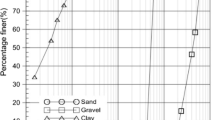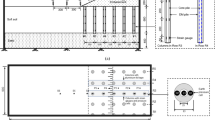Abstract
Many design guidelines have been proposed for piled embankments, most of which consider piles or columns as rigid inclusions. In this study, a small-scale physical model test was performed to investigate the load transfer mechanism of a geotextile-reinforced sand layer over a soft subsoil improved by semirigid columns. A multi-stage load was applied at the top of the sand layer until the columns started to yield. When the columns yielded, a reverse load transfer was observed. Vertical stresses were measured and analyzed in terms of efficacy and stress reduction ratio (SRR) with a comparison of existing design guidelines for assessing soil arching. Among the reviewed guidelines, the approach recommended by the Dutch guidelines provided the closest results to the experimental data, whereas the one adopted by the American guidelines predicted well the change in efficacy and SRR under different surcharge loads. However, the load transfer mechanism after the yielding of columns is beyond the scope of the existing design guidelines. In addition, it was found through regression analysis that the increment of vertical stresses on columns and surrounding soil followed an inclined line under partially undrained conditions during loading stages and a curve during consolidation.












Similar content being viewed by others
References
Airport Authority Hong Kong (2012) Expansion of Hong Kong international airport into a three-runway system project profile. http://www.epd.gov.hk/eia/register/profile/latest/esb250/esb250.pdf
ASTM (2005) 4595 Standard Test Method for Tensile Properties of Geotextiles by the Wide-Width Strip Method. ASTM Standards
BS 8006 (2010) Code of Practice for Strengthened/Reinforced Soils and Other Fills. British Standard Institution, UK
Butterfield R (1999) Dimensional analysis for geotechnical engineers. Geotechnique 49(3):357–366. https://doi.org/10.1680/geot.1999.49.3.357
EBGEO (2010) Empfehlungen für den Entwurf und die Berechnung von Erdkörpern mit Bewehrungen aus Geokunststoffen e EBGEO, vol. 2 German Geotechnical Society, Auflage978-3-433-02950-3 (in German). Also available in English: Recommendations for Design and Analysis of Earth Structures using Geosynthetic Reinforcements e EBGEO, 2011. ISBN: 978-3-433-02983-1 and digital in English ISBN: 978-3-433-60093-1.
Feng WQ, Yin JH, Chen WB, Tan DY, Wu PC (2020) A new simplified method for calculating consolidation settlement of multi-layer soft soils with creep under multi-stage ramp loading. Eng Geol 264:105322. https://doi.org/10.1016/j.enggeo.2019.105322
Filz GM, Smith ME (2006) Design of bridging layers in geosynthetic-reinforced, column-supported embankments. Virginia Center for Transportation Innovation and Research. http://hdl.handle.net/10919/46681
Filz GM, Sloan JA, McGuire MP, Smith M, Collin J (2019) Settlement and vertical load transfer in column-supported embankments. J Geotechn Geoenviron Eng 145(10):04019083. https://doi.org/10.1061/(ASCE)GT.1943-5606.0002130
Gibson RE, Gobert A, Schiffman RL (1989) On Cryer’s problem with large displacements. Int J Numer Anal Meth Geomech 13(3):251–262. https://doi.org/10.1002/nag.1610130303
Han J, Gabr MA (2002) Numerical analysis of geosynthetic-reinforced and pile-supported earth platforms over soft soil. J Geotechn Geoenviron Eng 128(1):44–53. https://doi.org/10.1061/(ASCE)1090-0241(2002)128:1(44)
Han J, Wayne MH (2000) Pile-soil-geosynthetic interactions in geosynthetic reinforced platform/piled embankments over soft soil. In Presentation at 79th annual transportation research board meeting, Washington, DC
Ho TO, Tsang DC, Chen WB, Yin JH (2020) Evaluating the environmental impact of contaminated sediment column stabilized by deep cement mixing. Chemosphere 261:127755. https://doi.org/10.1016/j.chemosphere.2020.127755
Ho TO, Chen WB, Yin JH, Wu PC, Tsang DC (2021) Stress-strain behaviour of cement-stabilized Hong Kong marine deposits. Constr Build Mater 274:122103. https://doi.org/10.1016/j.conbuildmat.2020.122103
Iglesia GR, Einstein HH, Whitman RV (2014) Investigation of soil arching with centrifuge tests. J Geotechn Geoenviron Eng 140(2):04013005. https://doi.org/10.1061/(ASCE)GT.1943-5606.0000998
Jamsawang P, Yoobanpot N, Thanasisathit N, Voottipruex P, Jongpradist P (2016) Three-dimensional numerical analysis of a DCM column-supported highway embankment. Comput Geotech 72:42–56. https://doi.org/10.1016/j.compgeo.2015.11.006
Kamruzzaman AH, Chew SH, Lee FH (2009) Structuration and destructuration behavior of cement-treated Singapore marine clay. J Geotechn Geoenviron Eng 135(4):573–589. https://doi.org/10.1061/(ASCE)1090-0241(2009)135:4(573)
King DJ, Bouazza A, Gniel JR, Rowe RK, Bui HH (2017) Load-transfer platform behaviour in embankments supported on semi-rigid columns: implications of the ground reaction curve. Can Geotech J 54(8):1158–1175. https://doi.org/10.1139/cgj-2016-0406
King DJ, Bouazza A, Gniel JR, Rowe RK, Bui HH (2017) Serviceability design for geosynthetic reinforced column supported embankments. Geotext Geomembr 45(4):261–279. https://doi.org/10.1016/j.geotexmem.2017.02.006
King L, King D, Bouazza A, Gniel J, Rowe RK (2021) Design of geosynthetic reinforced column supported embankments using an interaction diagram. Geotext Geomembr 49(1):159–165. https://doi.org/10.1016/j.geotexmem.2020.09.010
Kitazume M, Terashi M (2013) The deep mixing method. CRC Press, London
Lee T, van Eekelen SJM, Jung YH (2020) Numerical verification of the Concentric Arches model for geosynthetic-reinforced pile-supported embankments: applicability and limitations. Can Geotechn J 58(3):441–454. https://doi.org/10.1139/cgj-2019-0625
Liu KW, Rowe RK (2015) Numerical study of the effects of geosynthetic reinforcement viscosity on behaviour of embankments supported by deep-mixing-method columns. Geotext Geomembr 43(6):567–578. https://doi.org/10.1016/j.geotexmem.2015.04.020
Liu KW, Rowe RK, Su Q, Liu B, Yang Z (2017) Long-term reinforcement strains for column supported embankments with viscous reinforcement by FEM. Geotext Geomembr 45(4):307–319. https://doi.org/10.1016/j.geotexmem.2017.04.003
Low BK, Tang SK, Choa V (1994) Arching in piled embankments. J Geotechn Eng 120(11):1917–1938. https://doi.org/10.1061/(ASCE)0733-9410(1994)120:11(1917)
Phutthananon C, Jongpradist P, Jongpradist P, Dias D, Baroth J (2020) Parametric analysis and optimization of T-shaped and conventional deep cement mixing column-supported embankments. Comput Geotech 122:103555. https://doi.org/10.1016/j.compgeo.2020.103555
Rui R, Zhai YX, Han J, Van Eekelen SJM, Chen C (2020) Deformations in trapdoor tests and piled embankments. Geosynth Int 27(2):219–235. https://doi.org/10.1680/jgein.19.00014
Russell D, Pierpoint N (1997) An assessment of design methods for piled embankments. Ground Eng 30(10)
Schaefer VR, Berg RR, Collin JG, Christopher BR, DiMaggio JA, Filz GM, Bruce DA, Ayala D (2017) Ground modification methods reference manual—Volume I and II. Washington, DC: Federal Highway Administration. https://www.fhwa.dot.gov/engineering/geotech/pubs/nhi16027.pdf
Sloan JA (2011) Column-supported embankments: full-scale tests and design recommendations. Doctoral dissertation, Virginia Tech
Sloan J, Filz GM, Collin J (2011) A generalized formulation of the adapted terzaghi method of arching in column-supported embankments. In: Geo-Frontiers 2011: Advances in Geotechnical Engineering, pp 798–805 https://doi.org/10.1061/41165(397)82
Sun Z, Chen WB, Zhao RD, Jin YF, Yin JH (2023) Solidification/stabilization treatment of Hong Kong marine deposits slurry at high water content by ISSA and GGBS. Constr Build Mater 372:130817. https://doi.org/10.1016/j.conbuildmat.2023.130817
Sun Z, Chen WB, Zhao RD, Shen P, Yin JH, Chen YG (2023) Effect of seawater on solidification/stabilisation treatment of marine soft soil slurry by lime-activated ISSA and GGBS Engineering Geology 323:107216. https://doi.org/10.1016/j.enggeo.2023.107216
Terzaghi K (1943) Stress conditions for failure in soils. In: Theoretical soil mechanics. Wiley, New York, pp 11–15 https://doi.org/10.1002/9780470172766.fmatter
van Eekelen SJM, Bezuijen A, Lodder HJ, van Tol EA (2012) Model experiments on piled embankments. Part I. Geotextiles Geomembranes 32:69–81. https://doi.org/10.1016/j.geotexmem.2011.11.002
van Eekelen SJM, Bezuijen A, Lodder HJ, van Tol EA (2012) Model experiments on piled embankments. Part II. Geotextiles Geomembr 32:82–94. https://doi.org/10.1016/j.geotexmem.2011.11.003
van Eekelen SJM, Bezuijen A, Van Tol AF (2013) An analytical model for arching in piled embankments. Geotext Geomembr 39:78–102. https://doi.org/10.1016/j.geotexmem.2013.07.005
van Eekelen SJM, Bezuijen A, Van Tol AF (2015) Validation of analytical models for the design of basal reinforced piled embankments. Geotext Geomembr 43(1):56–81. https://doi.org/10.1016/j.geotexmem.2014.10.002
van Eekelen SJ, Brugman MH (2016) Design guideline basal reinforced piled embankments. CRC Press
van Eekelen SJ, Han J (2020) Geosynthetic-reinforced pile-supported embankments: state of the art. Geosynth Int 27(2):112–141. https://doi.org/10.1680/jgein.20.00005
van der Peet TC, van Eekelen SJM (2014) 3D numerical analysis of basal reinforced piled embankments. In: Tenth international conference on geosynthetics, pp 21–25
Waichita S, Jongpradist P, Schweiger HF (2020) Numerical and experimental investigation of failure of a DCM-wall considering softening behaviour. Comput Geotech 119:103380. https://doi.org/10.1016/j.compgeo.2019.103380
Wang HL, Chen RP, Liu QW, Kang X (2019) Investigation on geogrid reinforcement and pile efficacy in geosynthetic-reinforced pile-supported track-bed. Geotext Geomembr 47(6):755–766. https://doi.org/10.1016/j.geotexmem.2019.103489
Wang HL, Chen RP, Cheng W, Qi S, Cui YJ (2019) Full-scale model study on variations of soil stress in geosynthetic-reinforced pile-supported track bed with water level change and cyclic loading. Can Geotech J 56(1):60–68. https://doi.org/10.1139/cgj-2017-0689
Wijerathna M, Liyanapathirana DS, Jian Leo C (2017) Analytical solution for the consolidation behavior of deep cement mixed column–improved ground. Int J Geomechan 17(9):04017065. https://doi.org/10.1061/(ASCE)GM.1943-5622.0000954
Wood DM (2003) Geotechnical modelling, vol 1. CRC Press
Wu PC, Yin JH, Feng WQ, Chen WB (2019) Experimental study on geosynthetic-reinforced sand fill over marine clay with or without deep cement mixed soil columns under different loadings. Underground space 4(4):340–347. https://doi.org/10.1016/j.undsp.2019.03.001
Wu PC, Feng WQ, Yin JH (2020) Numerical study of creep effects on settlements and load transfer mechanisms of soft soil improved by deep cement mixed soil columns under embankment load. Geotext Geomembr 48(3):331–348. https://doi.org/10.1016/j.geotexmem.2019.12.005
Wu PC, Feng WQ, Qin JQ, Liu KF, Yin JH (2023) A New Calculation Method for Life Cycle Settlement of Soft Ground with Creep Treated by Columns. Int J Geomech. https://doi.org/10.1061/IJGNAI.GMENG-7899
Yapage NNS, Liyanapathirana DS (2014) A parametric study of geosynthetic-reinforced column-supported embankments. Geosynth Int 21(3):213–232. https://doi.org/10.1680/gein.14.00010
Yapage NNS, Liyanapathirana DS, Kelly RB, Poulos HG, Leo CJ (2014) Numerical modeling of an embankment over soft ground improved with deep cement mixed columns: case history. J Geotechn Geoenviron Eng 140(11):04014062. https://doi.org/10.1061/(ASCE)GT.1943-5606.0001165
Yapage NNS, Liyanapathirana DS, Poulos HG, Kelly RB, Leo CJ (2015) Numerical modeling of geotextile-reinforced embankments over deep cement mixed columns incorporating strain-softening behavior of columns. Int J Geomechan 15(2):04014047. https://doi.org/10.1061/(ASCE)GM.1943-5622.0000341
Yapage NNS, Liyanapathirana DS (2019) A review of constitutive models for cement-treated clay. Int J Geotech Eng 13(6):525–537. https://doi.org/10.1080/19386362.2017.1370878
Yin JH (2001) Stress-strain-strength characteristics of soft Hong Kong marine deposits without or with cement treatment. Lowland Technol Int 3:1–13
Yin JH (2004) Properties and behavior of a cement mixed Hong Kong marine clay and design applications. In: Proceedings of ground treatment, Hong Kong Geotechnical Society, Hong Kong, pp 97–105.
Yin JH, Fang Z (2006) Physical modelling of consolidation behaviour of a composite foundation consisting of a cement-mixed soil column and untreated soft marine clay. Geotechnique 56(1):63–68. https://doi.org/10.1680/geot.2006.56.1.63
Yin JH, Fang Z (2010) Physical modeling of a footing on soft soil ground with deep cement mixed soil columns under vertical loading. Mar Georesour Geotechnol 28(2):173–188. https://doi.org/10.1080/10641191003780872
Yin JH, Graham J, Clark JI, Gao L (1994) Modelling unanticipated pore-water pressures in soft clays. Can Geotech J 31(5):773–778. https://doi.org/10.1139/t94-088
Yu X, Zheng G, Zhou H, Chai J (2021) Influence of geosynthetic reinforcement on the progressive failure of rigid columns under an embankment load. Acta Geotech 16(9):3005–3012. https://doi.org/10.1007/s11440-021-01160-6
Zaeske D (2001) Zur Wirkungsweise von unbewehrten und bewehrten mineralischen Tragschichten über pfahlartigen Gründungselementen. Versuchsanst. Geotechnik, Univ. Gh Kassel, Fachgebiet u
Zhang J, Zheng JJ, Chen BG, Yin JH (2013) Coupled mechanical and hydraulic modeling of a geosynthetic-reinforced and pile-supported embankment. Comput Geotech 52:28–37. https://doi.org/10.1016/j.compgeo.2013.03.003
Zheng G, Yang X, Zhou H, Chai J (2019) Numerical modeling of progressive failure of rigid piles under embankment load. Can Geotech J 56(1):23–34. https://doi.org/10.1139/cgj-2017-0613
Acknowledgements
The work in this paper is supported by a Research Impact Fund (RIF) project (R5037-18) and three General Research Fund (GRF) projects (PolyU 15210020; PolyU 15210322; PolyU 15226722) from Research Grants Council (RGC) of Hong Kong Special Administrative Region Government of China. The authors also acknowledge the financial support from Research Institute for Land and Space of The Hong Kong Polytechnic University and three grants (CD82, CD7A) from The Hong Kong Polytechnic University.
Author information
Authors and Affiliations
Corresponding author
Additional information
Publisher's Note
Springer Nature remains neutral with regard to jurisdictional claims in published maps and institutional affiliations.
Rights and permissions
Springer Nature or its licensor (e.g. a society or other partner) holds exclusive rights to this article under a publishing agreement with the author(s) or other rightsholder(s); author self-archiving of the accepted manuscript version of this article is solely governed by the terms of such publishing agreement and applicable law.
About this article
Cite this article
Wu, PC., Chen, WB., Feng, WQ. et al. Load transfer mechanism of geotextile-reinforced sand layer over semirigid column-improved soft soil. Acta Geotech. (2024). https://doi.org/10.1007/s11440-023-02213-8
Received:
Accepted:
Published:
DOI: https://doi.org/10.1007/s11440-023-02213-8




